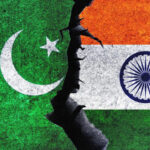Tiny spaces mark zones of privacy for riot victims in relief camps
Neat little squares tell a tale of their own at relief camps. Neat little squares, made up of meagre belongings, delineate the lines between one family and another. When you report on relief camps and speak to the victims, you note that these lines are lines of dignity, of a semblance of privacy, a remembrance of the homes they have fled, which had walls to protect them. The squares are a desperate attempt at a sense of order for men, women and children whose lives have been thrown out of gear and who are trying to retrieve something, anything, from their past that will quell their fears.
In Delhi, the squares are beginning to form again, as victims of the mob violence of last week come to terms with what they have lost. Many still don’t know the fate of their loved ones, and walk around with photos on their phones, asking anyone who visits to help find them.
Delhi violence | Looted, burnt out homes offer little welcome to Shiv Vihar’s riot victims
I first remember seeing those squares when I was 11, and had gone to deliver clothes at Delhi’s Lajpat Bhawan, where hundreds of victims of the anti-Sikh riots of 1984 had taken refuge. Lajpat Bhawan was run by the Servants of the People Society (SOPS), a civil society organisation started by Lala Lajpat Rai in the 1920s in his hometown Lahore, and then moved to Delhi post-Partition. Apart from providing other social services, SOPS would sell home-ground masalas, thus giving needy women a livelihood as well. The mob violence had affected both the rich and the poor. As relief trucks would come and dispense clothes, footwear and utensils, they would take them gratefully and then line their personal squares with them. Inside those squares the women would peel vegetables, make their children study, and try to recreate a small sense of home for themselves, something the smell of masalas in the air helped with.
In 2002, in Gujarat, I saw those squares again, while reporting on the mob violence that killed more than a thousand people, as the police stood by. Outside the Shah Alam relief camp, the violence continued to rock parts of the State for months, but inside it, those squares gave people a sense of safety. Often when we would go to interview them, they would lead us to their square so as to speak to us from the privacy of their “home” about the horrors they had faced.
In 2004, after the tsunami, I saw the squares once again, when I met a young couple at a camp in Port Blair. They had been evacuated from Car Nicobar. Each day, Indian Air Force planes would bring in survivors to the main island, and the husband and the wife would take turns to go look for their daughter, who was missing, leaving the other to guard their square. As journalists, we are schooled not to get personally attached to stories, but this story couldn’t but disturb. Their five-year-old daughter had gone to stay with her grandparents on the night of the tsunami, and there had been no word from her or their family since then. On our way back from the camps each day, my cameraman and I would stop at their square to check on them. When we found them both gone one evening, we were filled with foreboding. Fortunately, it turned out that their daughter had been found and they had gone running to see her, leaving their square unguarded for the first time in days. As they brought her back to their square, the whole camp cheered for that one moment of joy amidst all the sorrow. Taking a rare break from protocol, both my cameraman and I sat down and wept instead.
The search for dignity in a neat little square
Tiny spaces mark zones of privacy for riot victims in relief camps
Neat little squares tell a tale of their own at relief camps. Neat little squares, made up of meagre belongings, delineate the lines between one family and another. When you report on relief camps and speak to the victims, you note that these lines are lines of dignity, of a semblance of privacy, a remembrance of the homes they have fled, which had walls to protect them. The squares are a desperate attempt at a sense of order for men, women and children whose lives have been thrown out of gear and who are trying to retrieve something, anything, from their past that will quell their fears.
In Delhi, the squares are beginning to form again, as victims of the mob violence of last week come to terms with what they have lost. Many still don’t know the fate of their loved ones, and walk around with photos on their phones, asking anyone who visits to help find them.
Delhi violence | Looted, burnt out homes offer little welcome to Shiv Vihar’s riot victims
I first remember seeing those squares when I was 11, and had gone to deliver clothes at Delhi’s Lajpat Bhawan, where hundreds of victims of the anti-Sikh riots of 1984 had taken refuge. Lajpat Bhawan was run by the Servants of the People Society (SOPS), a civil society organisation started by Lala Lajpat Rai in the 1920s in his hometown Lahore, and then moved to Delhi post-Partition. Apart from providing other social services, SOPS would sell home-ground masalas, thus giving needy women a livelihood as well. The mob violence had affected both the rich and the poor. As relief trucks would come and dispense clothes, footwear and utensils, they would take them gratefully and then line their personal squares with them. Inside those squares the women would peel vegetables, make their children study, and try to recreate a small sense of home for themselves, something the smell of masalas in the air helped with.
In 2002, in Gujarat, I saw those squares again, while reporting on the mob violence that killed more than a thousand people, as the police stood by. Outside the Shah Alam relief camp, the violence continued to rock parts of the State for months, but inside it, those squares gave people a sense of safety. Often when we would go to interview them, they would lead us to their square so as to speak to us from the privacy of their “home” about the horrors they had faced.
In 2004, after the tsunami, I saw the squares once again, when I met a young couple at a camp in Port Blair. They had been evacuated from Car Nicobar. Each day, Indian Air Force planes would bring in survivors to the main island, and the husband and the wife would take turns to go look for their daughter, who was missing, leaving the other to guard their square. As journalists, we are schooled not to get personally attached to stories, but this story couldn’t but disturb. Their five-year-old daughter had gone to stay with her grandparents on the night of the tsunami, and there had been no word from her or their family since then. On our way back from the camps each day, my cameraman and I would stop at their square to check on them. When we found them both gone one evening, we were filled with foreboding. Fortunately, it turned out that their daughter had been found and they had gone running to see her, leaving their square unguarded for the first time in days. As they brought her back to their square, the whole camp cheered for that one moment of joy amidst all the sorrow. Taking a rare break from protocol, both my cameraman and I sat down and wept instead.






NO COMMENT